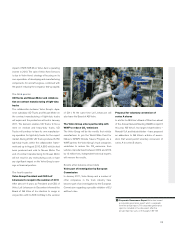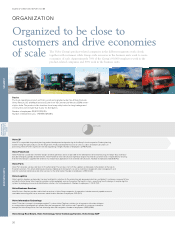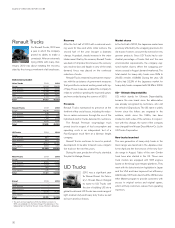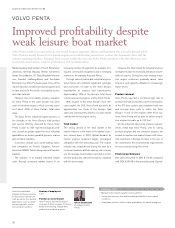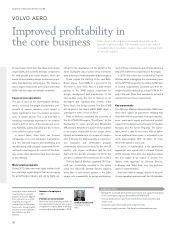Volvo 2010 Annual Report Download - page 36
Download and view the complete annual report
Please find page 36 of the 2010 Volvo annual report below. You can navigate through the pages in the report by either clicking on the pages listed below, or by using the keyword search tool below to find specific information within the annual report.
Ambitions 2010
• Profitable growth in all regions.
• Continued focus on cost-cutting and lower inventory levels.
• Increased sales of services and aftermarket products.
• Secure successful introductions of Euro V, EPA 2010 and hybrids.
BUSES
Increased sales and improved
profitability During 2010, Volvo Buses strongly improved its income due to a
customized product range, higher sales and a strong focus on cost
reductions.
Volvo Buses is one of the world’s largest manu-
facturers of heavy buses. The range comprises
complete buses, chassis, transport solutions,
telematic systems, financial solutions, as well as
service and maintenance contracts. The com-
pany offers global products adapted to local con-
ditions, with manufacturing in Europe, Asia, North
America, South America and Africa.
Volvo Buses has sales in about 85 countries
and one of the bus industry’s strongest service
networks, with more than 1,500 retailers and
service workshops globally.
Focus on cost-efficient solutions
In the bus industry, focus remains on developing
cost-efficient transport solutions and reducing
energy consumption and the impact on the envir-
onment. It is about lower fuel consumption, alter-
native fuels and alternative energy sources.
During the year, Volvo Buses began delivering
buses that comply with the tough Euro V emis-
sion requirements in Europe and EPA2010 in
North America, including buses with the new
13-liter engine. The response from customers
has been very positive, both in terms of improved
performance and reduced fuel consumption.
Serial production of hybrid buses
During the year, the company also took an import-
ant step toward significantly reducing energy
consumption in terms of city buses. In May, serial
production commenced on the Volvo 7700 Hybrid
buses and Volvo B5L Hybrid double-decker
buses. By recycling the brake energy, the buses
will be able to operate partly on electricity, which
will contribute to a reduction in fuel consumption
of up to 35% and, accordingly emissions of the
greenhouse gas, carbon dioxide. Volvo’s hybrid
buses currently operate in several cities around
Europe. Interest is high worldwide and during the
year, the hybrid buses were test-driven in Brazil,
Colombia and Mexico.
Developing aftermarket
However, high-quality buses are not sufficient.
Customers need a strong support in the after-
market. This applies to telematics, which assists
customers in controlling traffic, conducting fol-
low-ups of fuel consumption, for example, and in
planning service. Volvo Buses’ telematic system,
ITS4mobility, is one of the world’s best and a third
step, Vehicle Management, was introduced dur-
ing the year. This means that customers are able
to remotely read all signals from the buses’ con-
trol system and thus plan future service meas-
ures, resulting in reduced costs.
Increased deliveries
Despite the weak trend reported during the year
for the total market for Volvo Buses’ key markets
in Europe and the coach market in North Amer-
ica, Volvo succeeded in increasing deliveries
compared with 2009. During the year, 10,229
buses and bus chassis (9,857) were delivered.
Sales increased in several locations in Asia, for
example, in India and Australia, as well as in
South America and in the Nordic region. During
the year, Volvo Buses was able to strengthen its
market shares in several markets.
Increased sales and improved profits
Net sales rose in 2010 to SEK 20,516 M (18.465).
Operating income rose from a negative SEK 350
Buses has a product range
comprising city and intercity
buses, coaches and chassis.
Håkan Karlsson
President of Volvo
Buses.
Number of employees
7,665
Position on world market
The business area is one of the
world’s largest producers of buses.
Brands
Volvo, Prevost, Nova, Sunwin and
Silver.
BOARD OF DIRECTORS’ REPORT 2010
32





